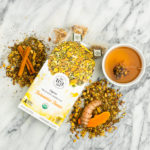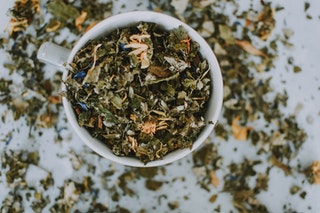In the United States, we tend to call everything we steep in hot water “tea.” Many of these best-selling steeped beverages – including peppermint, chamomile, hibiscus, and sleepy teas – are not technically tea. These are herbal infusions. They tout a medicinal legacy as rich and diverse – and even more ancient – than that of tea. Of course, within the current social environment with COVID-19, our top priority is keeping ourselves and our families safe, which has us focusing on healthy essentials, such as tea. Herbal teas are in strong demand, as a result – particularly those which can bring us comfort as well as some sense of enjoyment.
Natural Antivirals
Of course, it’s important to point out that no tea beverage or herbal infusion can treat, cure or prevent any disease, including COVID-19, and many of their traditional therapeutic uses have yet to be substantiated by modern research. However, research studies have shown that coronaviruses may be inhibited by phytochemicals abundant in certain herbs, and that plays a big part in why so many people have turned to enjoy them during the ongoing pandemic. Consumers are seeking simple, natural and affordable herbal teas for general wellness, boosting immunity, or for specific functional purposes, such as aiding with sleep, energy levels or stress reduction.
Undeniably, natural remedies with perceived antiviral action – such as herbal tea blends – spiked in demand during the pandemic. This is because certain herbals have a reputation for boosting overall wellness and immunity, and some have even demonstrated inhibitory actions against viral infection replication.
But how do antiviral herbs work? When one hears the term “antiviral,” it’s easy to jump to the wrong conclusion, thinking that they’re something to take to kill pathogens. But antivirals do not function that way. Viruses are said to be “organisms at the edge of life,” tiny organic structures that don’t have a cell wall. They interact with living organisms in order to exist and replicate and will invade all types of cellular life to do so. How natural antiviral compounds work – including those in tea blends or herbal tea blends – is to effectively inhibit the early stage of attachment or replication of the virus once it gets into your cells.
10 Functional Herbal Ingredients for Overall Wellness
When looking for herbal teas that are beneficial for wellness, look for blends that include one or more of the following herbs and/or adaptogens.
 1. Turmeric Root – Turmeric has been gaining traction rapidly in the herbal category, primarily sought after for its potent anti-inflammatory and antioxidant properties. Linked to a wide range of functional benefits, from lowering the risk of heart disease to improving symptoms of depression and arthritis, its vibrant yellow color comes from its main active ingredient, curcumin. Soothing and caffeine-free, Golden Milk is a popular format for drinking turmeric that comes from the Indian traditional medicinal system of Ayurveda.
1. Turmeric Root – Turmeric has been gaining traction rapidly in the herbal category, primarily sought after for its potent anti-inflammatory and antioxidant properties. Linked to a wide range of functional benefits, from lowering the risk of heart disease to improving symptoms of depression and arthritis, its vibrant yellow color comes from its main active ingredient, curcumin. Soothing and caffeine-free, Golden Milk is a popular format for drinking turmeric that comes from the Indian traditional medicinal system of Ayurveda.
2. Astragalus Root – Astragalus is best known for its traditional use as a tonic to support Chi, the conceptual strength and vitality “shield” which serves as a primary defense against threats to the body. This is a fundamental herb in traditional medicine and is often included in recipes for soups used for convalescence and general strengthening of the system. This active ingredient is Astragalus polysaccharide (APS), which has been researched for its immune-enhancing and antiviral qualities.
3. Ginger Root – Ginger’s unique fragrance and flavor come from its natural oils, the most important of which is gingerol. This main bioactive agent in ginger has been researched extensively for its powerful antioxidant and anti-inflammatory properties. Ginger has been used traditionally to support a wide range of functions, including digestion, relieving symptoms of nausea, and in support against common colds and influenza. Recent studies have focused on its potential for natural prevention and inhibition of these ailments.
4. Lavender Flower – Lavender’s relaxing effects are thought to come primarily from its aromatic essential oils. The scent of lavender, inhaled while drinking an infusion from the flowers, offers a calming aroma that may help unwind and ease into sleep. Lavender tea has a variety of sweet and floral notes, including rosemary and mint.
5. Chamomile Flower – Chamomile has been used traditionally to treat insomnia and help induce sleep. Its main active ingredient is the flavonoid antioxidant Apigenin, which may be responsible for these sedative effects. Its soothing aroma and calming effects make it the perfect nightcap and top ingredient in many sleepy teas. Brews with Chamomile typically have a sweet, light taste.
6. Valerian Root – Valerian has also been used for many centuries as a sleep aid. Today, its mechanisms for relieving insomnia and nervous anxiety are attributed to its ability to inhibit and suppress stress responses in the brain. Valerian root has a strong, pervasive, earthy odor due to the Valeric acid and other active compounds responsible for its sedative effects.
7. Ashwagandha Root – An important herb known for promoting vitality in traditional Ayurveda (a type of holistic medicine). Though caffeine-free, it is commonly used as an energy, cognition and mood booster. This root is bitter and pungent.
8. Rhodiola Rosea – One of the strongest adaptogens, traditionally used in Nordic and Russian folk medicine to ward off fatigue and improve mood and cognitive performance. Today, it’s commonly used in anti-anxiety formulations. Rhodiola is sweet and lightly fragrant.
9. Tulsi Holy Basil – Tulsi, a calming and aromatic herb, has been widely used in traditional Ayurveda to manage metabolic as well as psychological stress. It can be found in many tea blends on the market today.
10. Maca Root – Maca Root is sought after for is reputed libido, fertility, mood, and memory-boosting effects. Scientific research on this herb from the Peruvian highlands has focused on its efficacy in supporting sexual function and as a promising adaptogen in mitigating the effects of UV radiation and osteoarthritis. Its taste is earthy and nutty.
Herbal Teas and Self-Care
In 2021, people will continue to prioritize wellness and self-care. Natural ways to strengthen immunity and help reduce stress, or ways to bring one’s self “back into balance” will be highly sought after. Functional botanical herbals fit nicely with those needs and will stay in the forefront of consumers’ minds, in the time of Corona, and well into the future.
Maria Uspenski is the Founder and CEO of The Tea Spot, where her mission is to advance and empower healthy living through premium loose-leaf tea. Uspenski is also the author of Cancer Hates Tea and was recognized as a “Top Tea Health Advocate” by the World Tea Conference + Expo. She’s been featured in leading media outlets for her success as a social entrepreneur and as a certified tea and fitness nutrition expert. To learn more, visit TheTeaSpot.com.
References:
[1] Naithani, Rajesh et al., Antiviral Activity of Phytochemicals: A Comprehensive Review, Mini-Reviews in Medicinal Chemistry, Bentham Science Publishers, Volume 8, Number 11, 2008, pp. 1106-1133(28)
[2] Shilpa Patil and Shweta Patil, An appraisal on antiviral assets of some spices, Journal of Medicinal Plants Studies 2020; 8(5): 49-51
The post Top 10 Herbal Teas That People Love Amidst COVID-19 appeared first on LivingBetter50.







